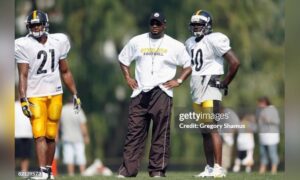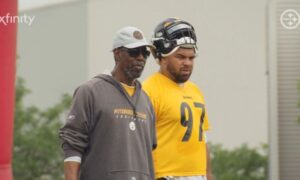The pass defense of the Steelers seemed to be the focal point of the offseason, whether it be the criticisms bubbling over from the past few subpar seasons and the “neglect”, if you will” by the front office of devoting talent or early draft picks to it, or the retirement of several stalwarts, most notably safety Troy Polamalu.
This offseason, there were several names available in free agency but the team chose to wait until the draft to let their actions speak, selecting two corners within their first four picks. Not only the secondary, but the team’s pass rush was viewed as questionable, with Jarvis Jones failing to live up to expectations and Jason Worilds retiring. The team had an athletic marvel fall to them in the form of first-rounder Bud Dupree, and if his potential can translate more consistently to the field, he’ll amp up the pass rush in a hurry.
What about the run defense you may ask? Well, stat-wise, the team finished sixth against the run in yards allowed per game, an outstanding mark. It’s not what many fans are used to, with the likes of Casey Hampton, Aaron Smith or Brett Keisel shutting down running lanes but it’s worthy of praise. But is it misleading?
It’s clear to anyone watching that the glaring weakness of the team was the secondary, and if I can notice it, odds are 32 of the defensive coordinators in the league have noticed it. The Steelers ranked 25th in pass yards allowed per game with 253, and teams threw the ball on them an average of 33 times per game. To put that in perspective, teams only ran the ball against them an average of 23 times per game, or third-fewest in the league.
A staple of Pittsburgh over the years has been stopping the run, especially on first down, which puts the teams in precarious situations come second and third down. However, Pittsburgh gave up 5.5 rushing first downs per game last year, ranking 13th. This means that although teams shied away from the run versus them, they went back to it when it mattered most and that was to move the chains.
There are several positives to draw on though, and one of them is new defensive boss, Keith Butler, who promises to add more exotic looks to the defense, including more blitzes. This aggressive strategy will help produce more runs that are either stuffed at or behind the line of scrimmage, thus vaulting the team up in the run defense standings. Another positive is the fact that the team appears to be two-deep across the line, making it likely that Cam Thomas is a camp casualty.
Last season, he graded out as the worst 3-4 defensive end on the year versus the run, and the team could likely pick up a street free agent who would play with more passion and tenacity than him. But with the emergence of second-year end Stephon Tuitt, as well as the raw-but-gifted sixth round pick, Leterrious “L.T.” Walton, Thomas may face an uphill battle in securing a roster spot.
The team’s run defense was not as superb as it’s sixth overall ranking from 2014 may indicate, but it may have been overlooked by other deficiencies across the defense. However, with many younger players entering their second years, including gargantuan nose tackle Daniel McCullers, the game should slow down and allow the players to focus on their duties. Facing off against some of the league’s premier backs like Marshawn Lynch, Jamaal Charles or second-year stud Jeremy Hill twice will be a great barometer about the improvement from 2014.








